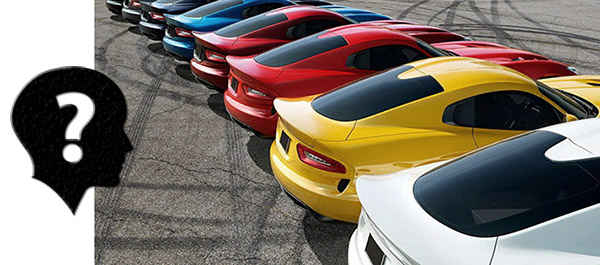What is the least popular car colour?
Understanding the least popular car colors involves considering various factors – example: cultural preferences, trends, geographic location, and more.
Based on data from numerous surveys and studies, certain colors consistently rank lower in popularity among car buyers:
- Pink
- Brown
- Orange
- Yellow
- Purple
Reasons for Low Popularity

- Pink
Association with Gender: Pink is often linked with femininity, which can dissuade many potential buyers who favor neutral or traditionally masculine colors.
Visibility: Pink cars are highly visible and stand out in traffic, which may not be desirable for buyers seeking a more understated look.
Resale Value: Pink cars tend to have lower resale values, making them less attractive to buyers considering long-term investment.
- Brown
Dullness: Brown is often perceived as a dull or unattractive color, lacking the sleekness or modern appeal of colors like black, white, or silver.
Fashion Trends: Brown tends to go in and out of fashion, making it a less stable choice for those looking for a timeless vehicle color.
Market Perception: Brown may be associated with older or less desirable vehicle models.
- Orange
Brightness: Orange is a very bright and bold color, which can be off-putting for those who prefer more conventional or neutral tones.
Limited Appeal: It generally appeals to a niche market, example: sports car enthusiasts or those desiring a unique look, rather than the broader car-buying public.
Seasonal Preferences: Orange may be less popular in certain seasons or regions, impacting its overall desirability.
- Yellow
Boldness: Similar to orange, yellow is a very bold and bright color. While it stands out, it can also be seen as too flashy or gaudy for everyday use.
Resale Value: Yellow cars often have lower resale values, which can deter buyers who consider the long-term financial implications of their purchase.
Specific Uses: Yellow is often associated with commercial vehicles like taxis, which can affect its appeal for personal use.
- Purple
Rarity: Purple is rarely offered by manufacturers, making it an uncommon choice.
Perception: It can be viewed as a whimsical or unconventional color, which might not align with the tastes of many car buyers.
Market Demand: Limited demand can lead to fewer options and higher costs for purple cars.
Interesting Facts

Cultural Influence:
In some cultures, specific colors have unique meanings influencing car color popularity. For instance, in China, red is highly popular because it symbolizes good luck and happiness.
Safety Considerations:
Some studies suggest that certain colors, example: white, are safer because they are more visible in various lighting conditions. Conversely, darker colors like black or dark blue might be less visible at night, potentially increasing accident risk.
Climate Impact:
In hot climates, lighter colors like white or silver are often preferred because they reflect more sunlight and help keep the car cooler.
Trends:
Car color trends can change over time. For example, while metallic colors were very popular in the early 2000s, matte finishes have gained popularity more recently.
Customization:
Despite general trends, the ability to customize cars has allowed for a broader range of color choices. Some car enthusiasts take pride in having unique or uncommon colors.
Regional Differences:
Preferences for car colors can vary significantly between regions. What is unpopular in one area might be more accepted or even trendy in another.
News and Trends


Sustainability Trends:
With the increasing focus on sustainability, some manufacturers are exploring eco-friendly paint options, including colors that reflect sunlight better and reduce the need for air conditioning, which could influence future color popularity.
Technological Advancements:
Advances in paint technology, example: self-healing coatings and color-changing paints, could shift consumer preferences and introduce new trends in car colors.
Electric Vehicles (EVs):
The rise of electric vehicles has seen a trend towards futuristic and clean colors like white, silver, and blue, which may influence the overall popularity of car colors.
While preferences can vary widely, colors like pink, orange, purple, yellow, and brown typically rank lower in popularity among car buyers. Factors – example: cultural perceptions, visibility, resale value, and personal taste all play a role in these trends.
Understanding these reasons can help in making informed decisions when choosing a car color, and staying updated on current trends and technological advancements can provide further insights into future shifts in car color popularity.












